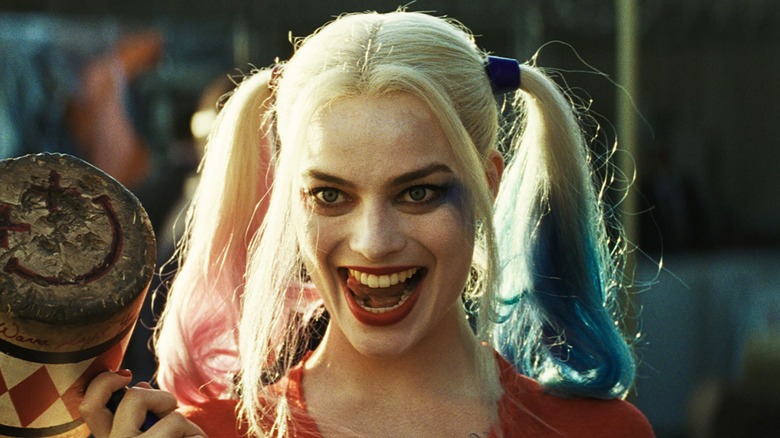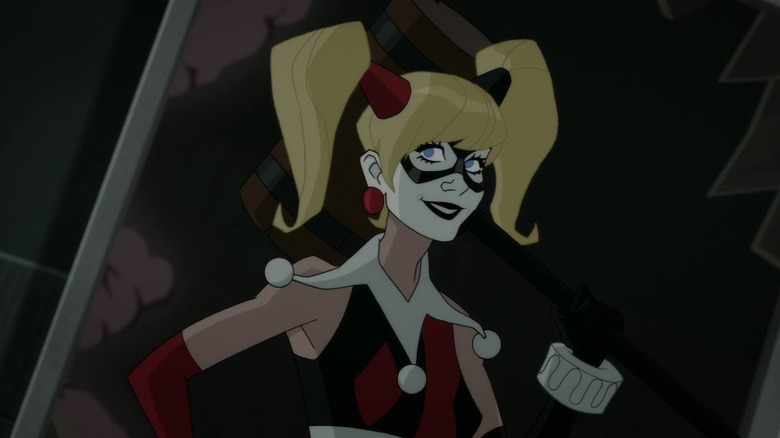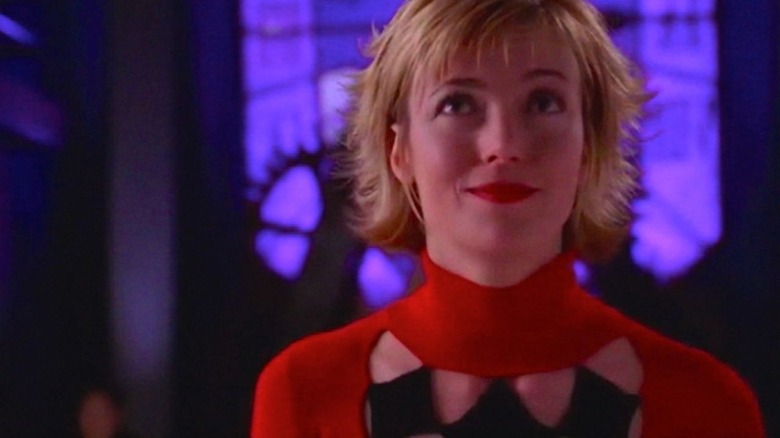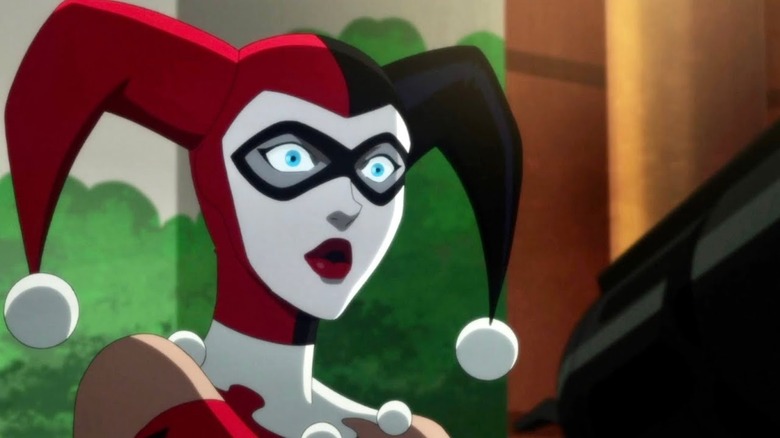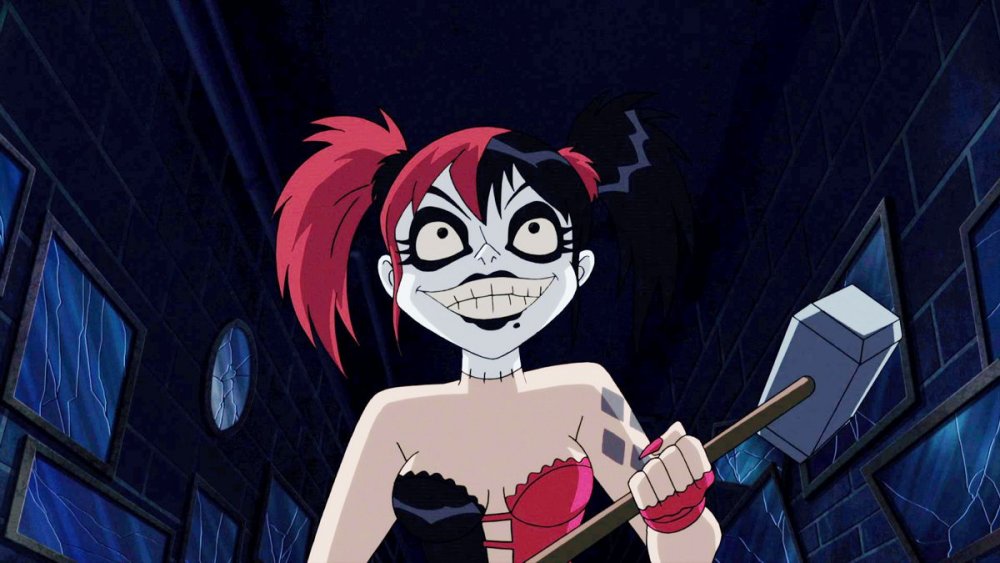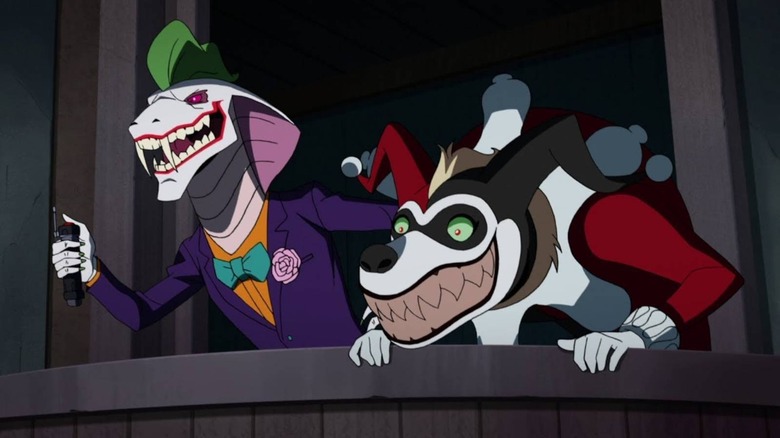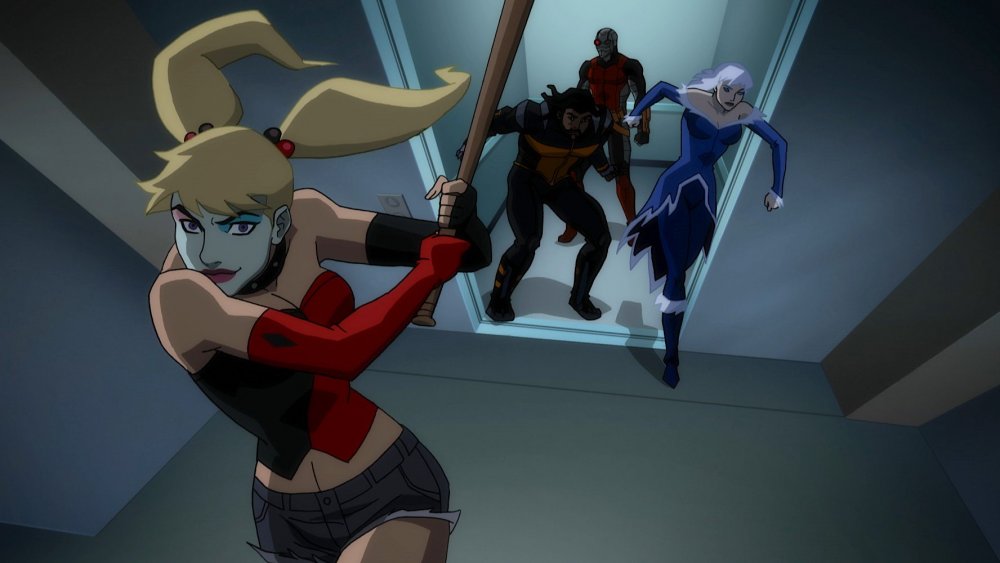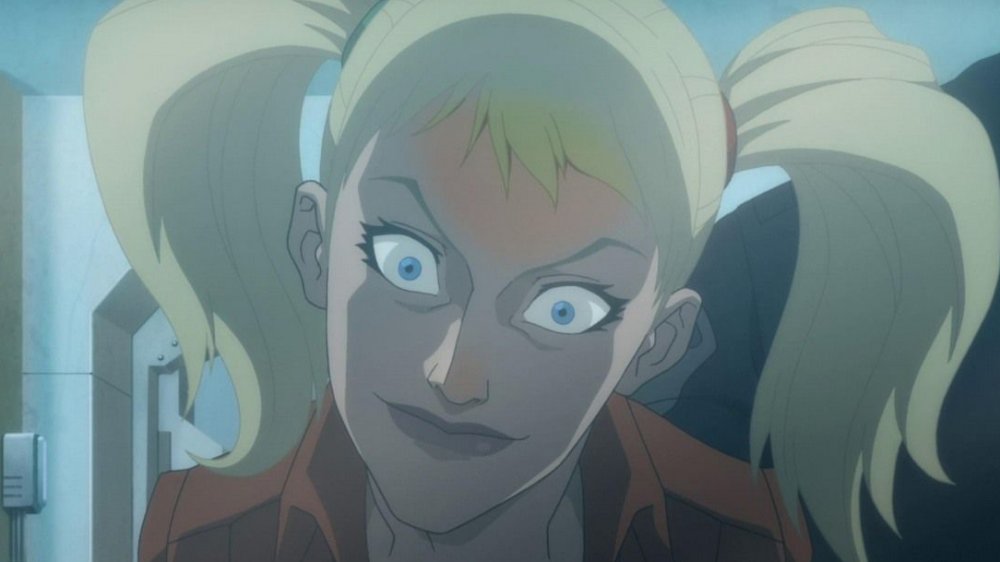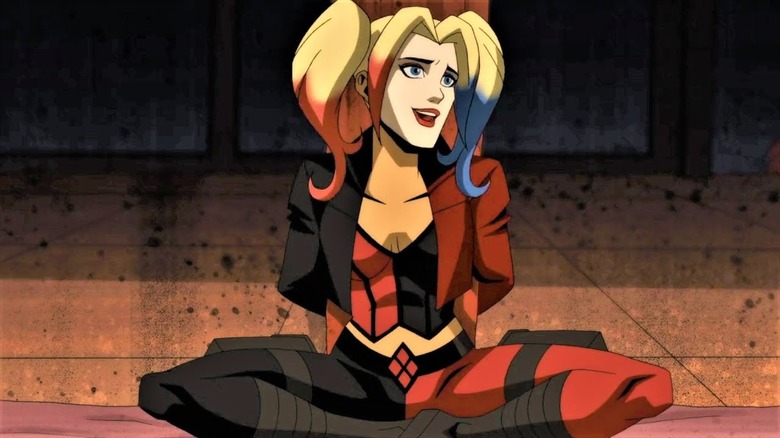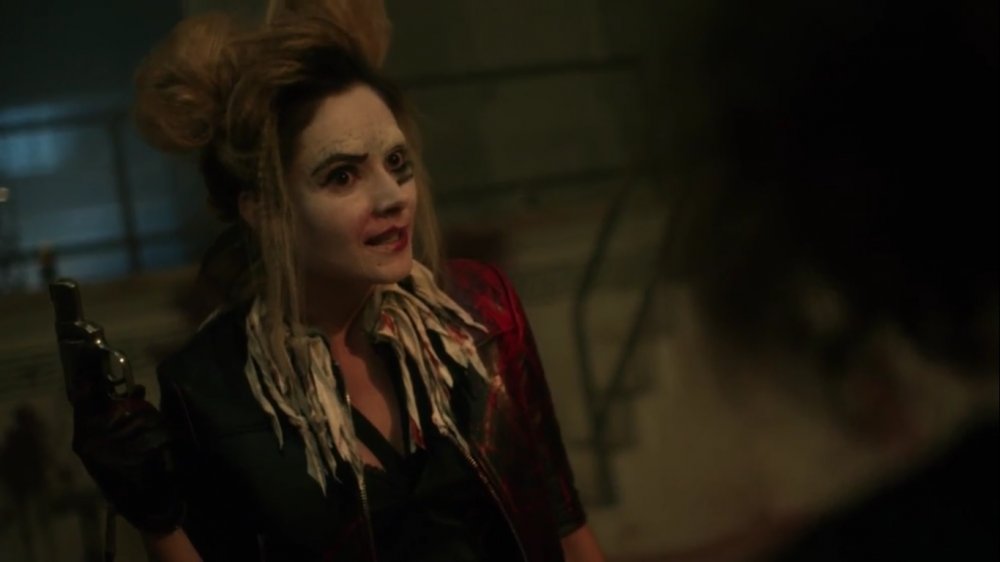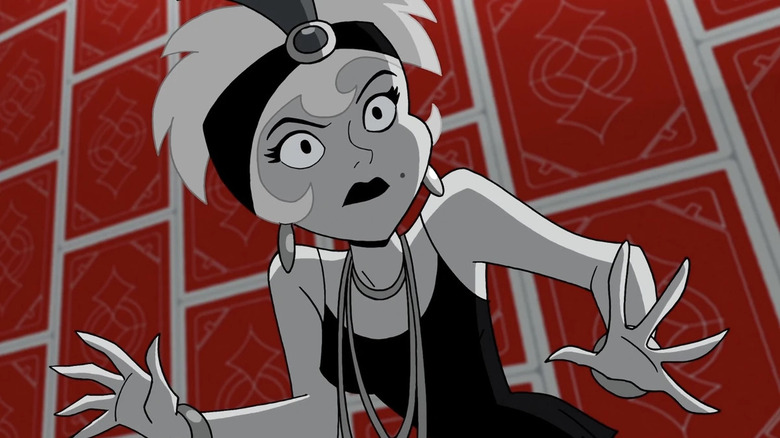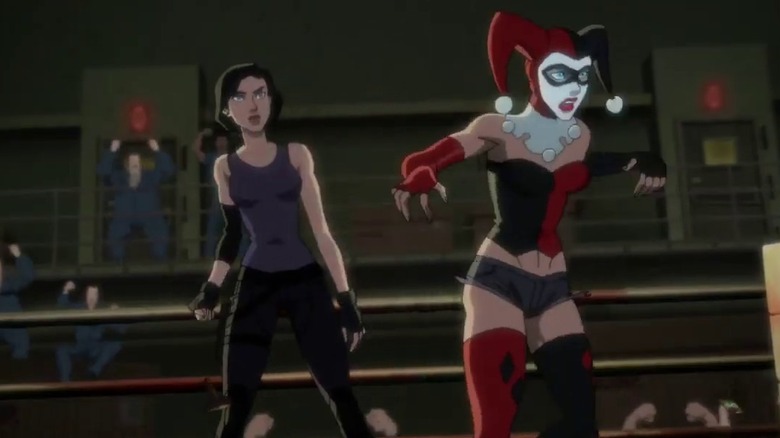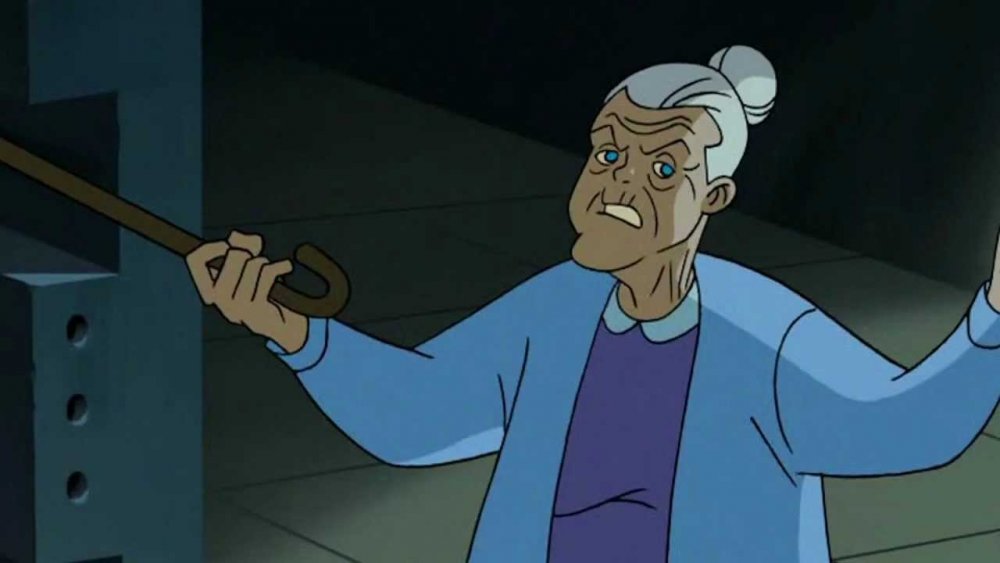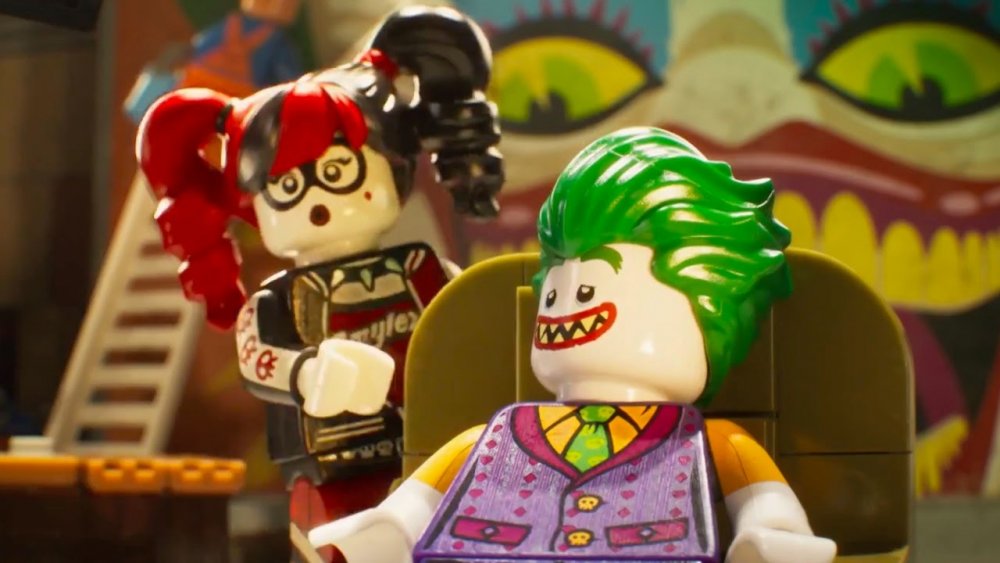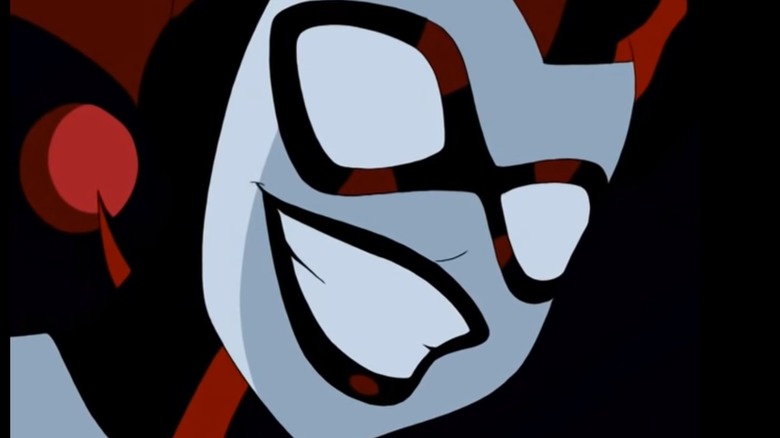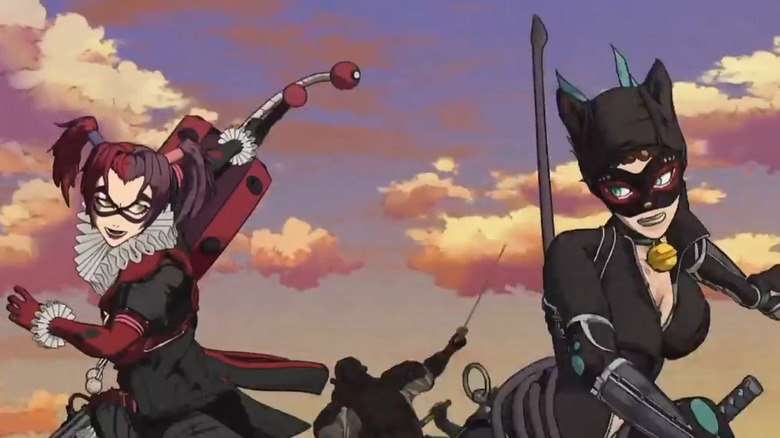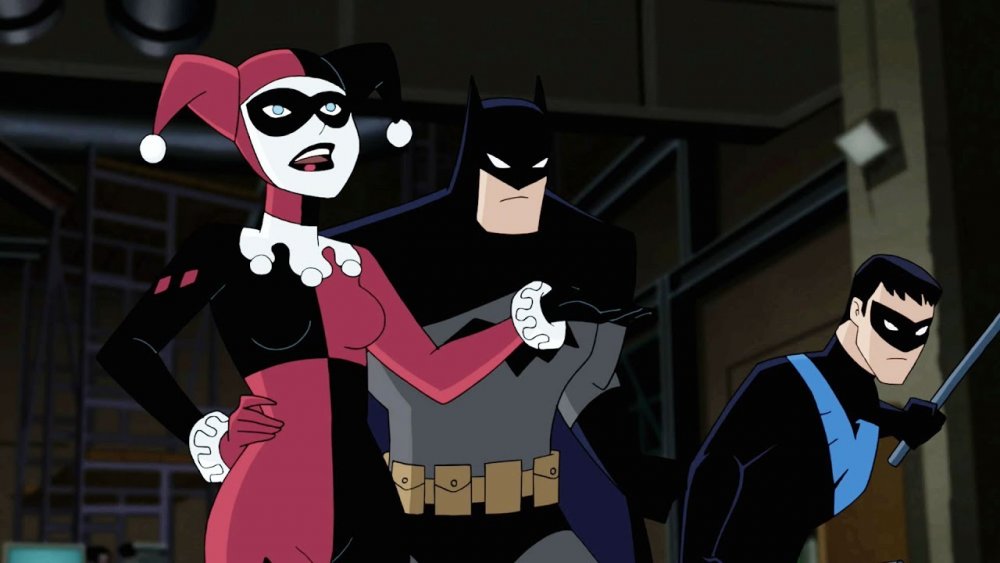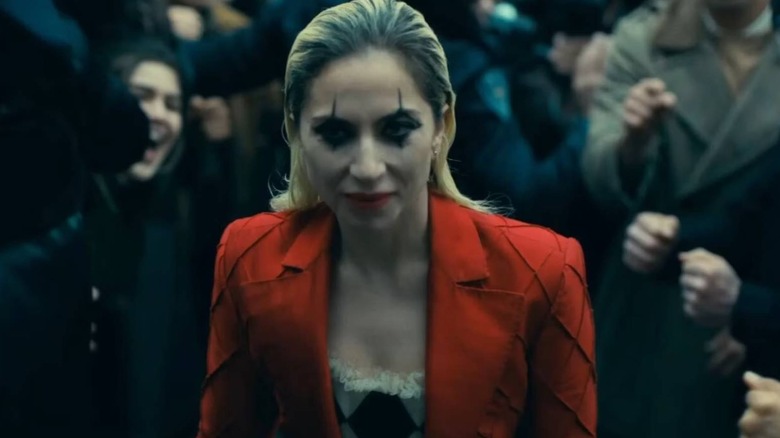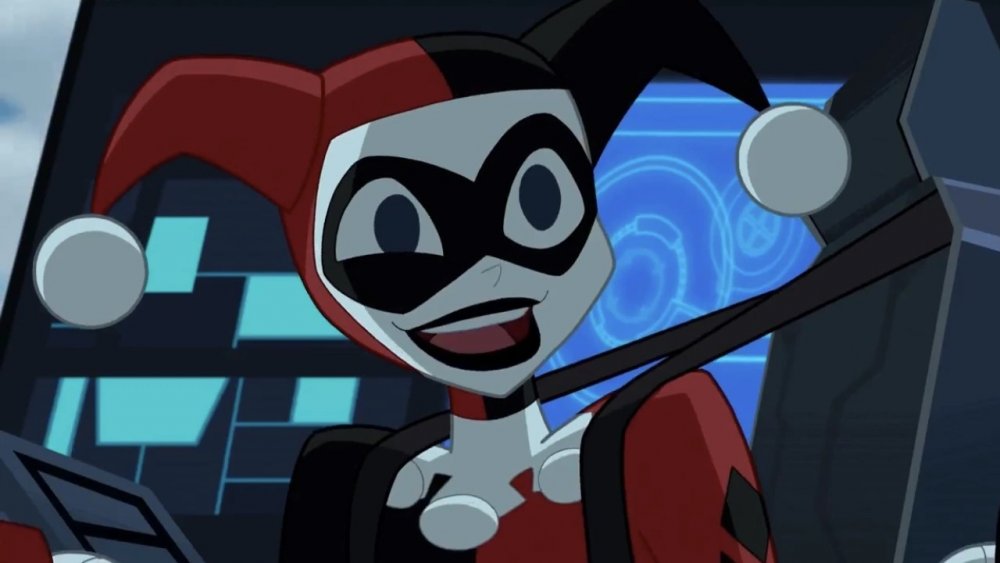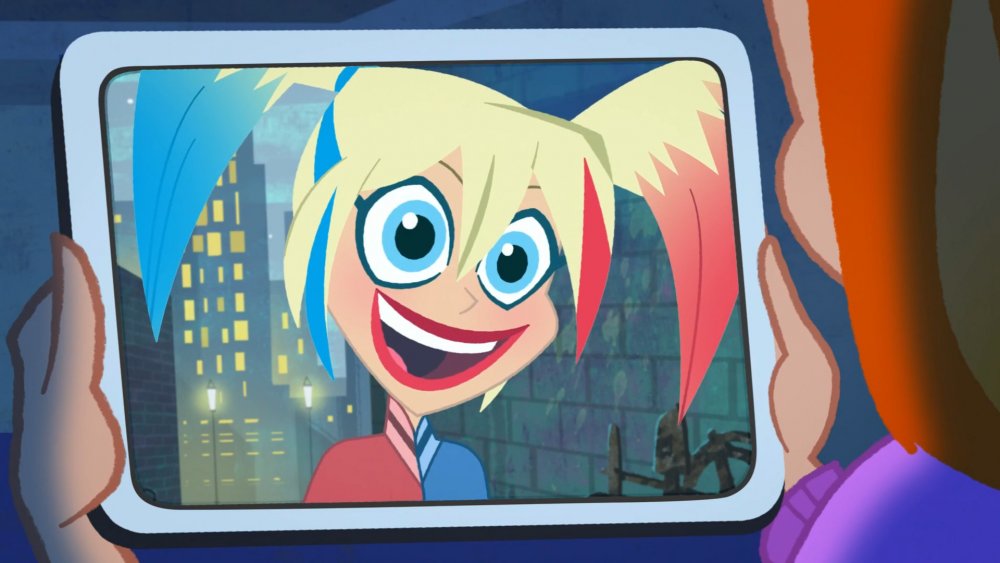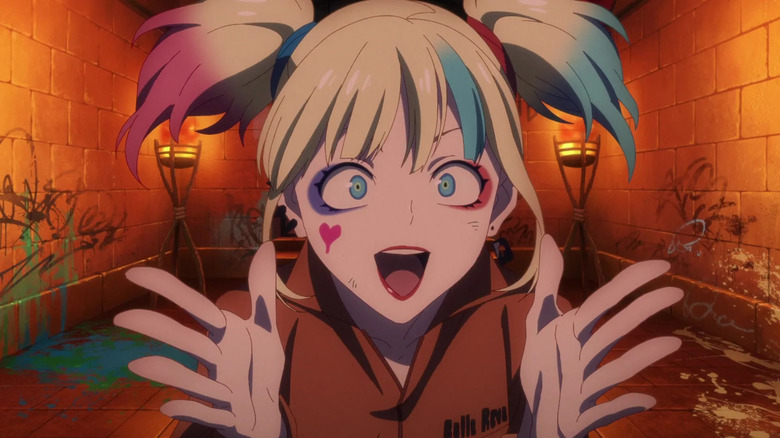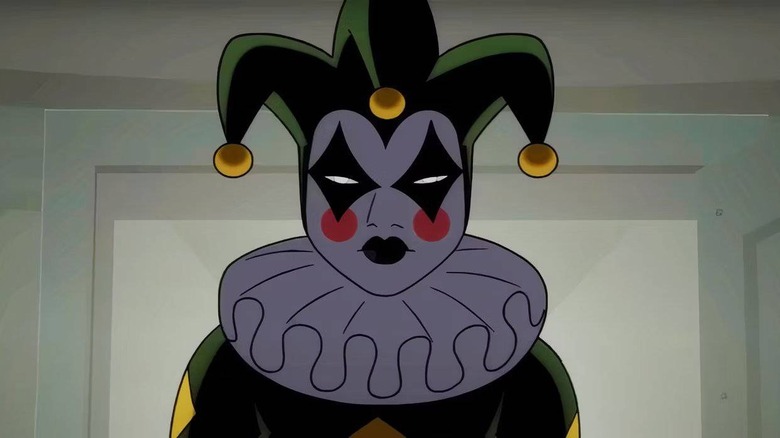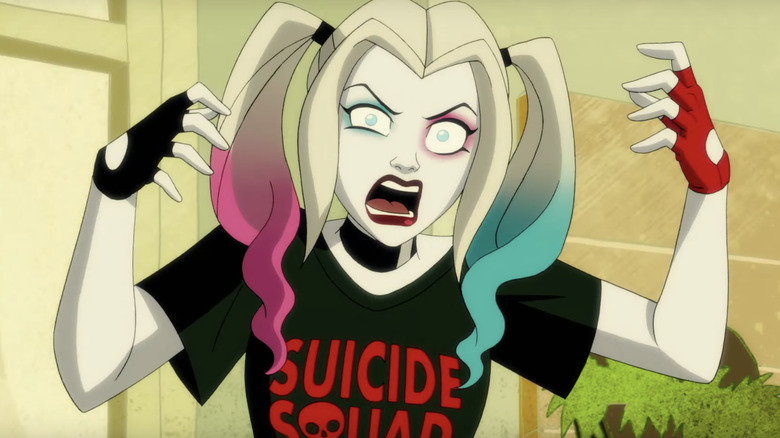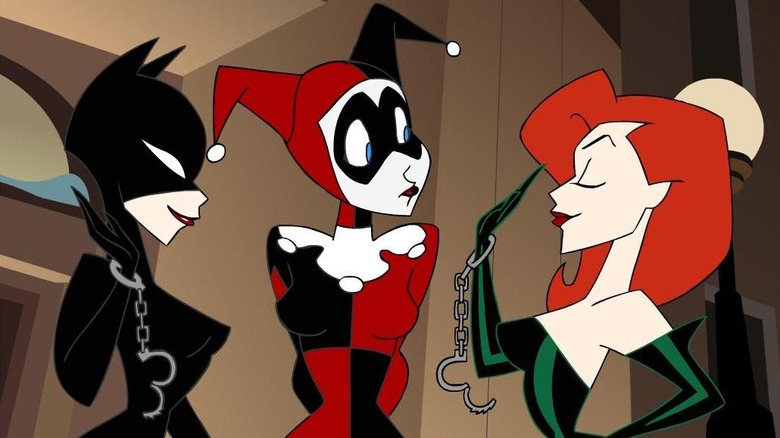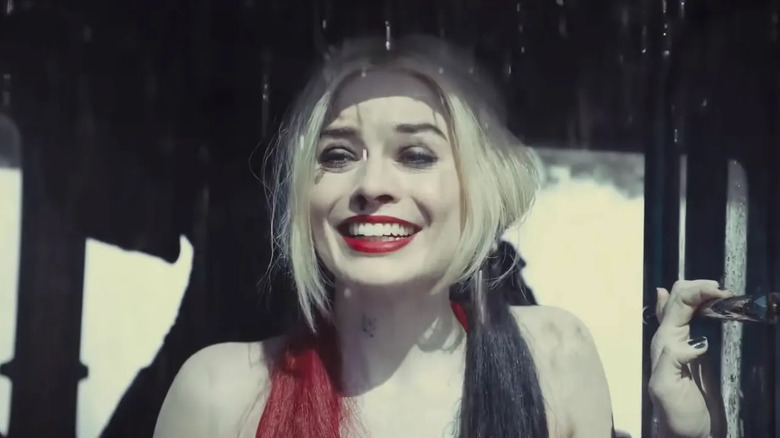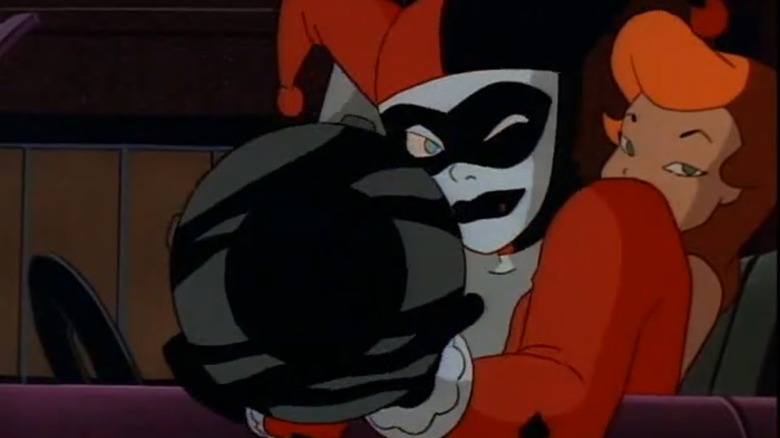Every Screen Version Of Harley Quinn Ranked Worst To Best
Since her humble beginning as the Joker's lovelorn sidekick in 1992's "Batman: The Animated Series," Harley Quinn has risen to the heights of superheroic success. She's in cartoons. She's in movies. She's in video games. She's on T-shirts. She's an enduring Halloween costume choice. Harley isn't just a breakout character but a bona fide icon, beloved across the world for her trademark blend of comedy and heartbreak.
Like all the best comic characters, she contains multitudes. Some love her as the tragic girlfriend, some enjoy her slapstick charm, and some gravitate to her as an independent anti-heroine. All of these renditions are Harley Quinn, just as Adam West's 1960s swinger and Christian Bale's Dark Knight are both Batman. She is many, and yet she is singular.
Not all Harley Quinns are created equal, however. There are smoldering failures among her many on-screen portrayals, as well as soaring successes. Where's a fan to start, given the sheer number of Harleys to choose from? We're here to answer that question the best way we know how — by examining each and every on-screen Harley Quinn and ranking them from the utter worst to the absolute best. Pin up your pigtails, it's going to be a bumpy, joke-filled, mallet-swinging ride.
25. Batman vs. Two-Face
Two-Face never actually appeared on the 1960s "Batman" show starring Adam West. It took decades for fans to see what his inclusion might have looked like with the animated film "Batman vs. Two-Face," which was the final Batman project West ever worked on. It's pure campy fun, as Hugo Strange (Jim Ward) develops a machine that can suck the evil out of anyone. The only problem is that it explodes, partially covering Harvey Dent (William Shatner) in liquefied evil and turning him into the villainous Two-Face.
Harleen Quinzel, voiced by Sirena Irwin, is Hugo Strange's assistant, and that's pretty much the extent of her role unless you watch an exclusive scene on the Blu-ray release. The extra scene sees Harleen break Joker (Jeff Bergman) out of a cell, donning the new name of Harley Quinn. There's really nothing here to make the character stand out, even if it's cool to see what Harley Quinn's design might have been like had she existed in the 1960s.
It feels as though the extra scene is setting up a sequel that'll never come to pass, now that Adam West is no longer with us. While "Batman: Return of the Caped Crusaders" and "Batman vs. Two-Face" offer some throwback fun, there's no point in doing another one without West. This Harley seems destined to remain a one-and-done.
24. Birds of Prey (TV)
Long before the Birds of Prey were best known for being led by the fantabulously emancipated Harley Quinn, they were tearing up the 2002 TV screen ... for a year, at least. Only one season was ever produced of the series, after its impressive premiere numbers gave way to a steep decline in viewership. It's an odd little series, notably averse to comic book canon. Sure, it's got Oracle (Dina Meyer) working out of Gotham's clocktower, but it also has a telepathic Black Canary (Rachel Skarsten), a Gotham that's been abandoned by Batman, and a Huntress (Ashley Scott) who, in addition to being Bruce Wayne's estranged daughter, was born to a Catwoman with literal cat powers that she can also manifest through strong emotion.
Nothing, however, tops the show's take on Harley Quinn for sheer strangeness. The show's antagonist, Harley is a conniving psychiatrist out for revenge on the Gotham elite who incarcerated her Mr. J. It's not a terrible idea on its own, but Mia Sara's Harley shares little in common with the maven of mayhem that fans know and love. She smirks in lieu of cackling, coolly lays out her complex plans, and generally lacks the anarchic glee that makes Harley such a beloved character. This makes sense, given the show's sleek approach to superheroics, but it sure does make for sub-par Harley content.
23. Batman: Hush
There's a saying that there are no small parts, only small actors. With just over a minute of screen time, Harley isn't a major force in the animated "Batman: Hush," but she gets a standout moment in a film with a lot of them. She's really only there to disrupt an opera and try to kill Bruce Wayne (Jason O'Mara) on the orders of Hush (Geoffrey Arend), who's kidnapped Joker. Voice actor Hynden Walch makes the most of her brief appearance, and there's certainly some thematic resonance of seeing Harley knock out a singing clown. But there's so much story to tell in "Hush" that things quickly need to move along.
The "Hush" comic really exists as a rundown of the entire Batman mythos, with a new antagonistic force at the center. Batman takes on many classic villains, fights Superman, and even has a crisis of faith as he questions whether he should have let Joker live all this time. Harley is integral to that mythos, so it makes sense she'd factor into the story, no matter how briefly.
But when ranking all of the various permutations of Harley, this one feels like "Been there, done that." Her opera attack is a fun sequence, but there's not much else to distinguish this Harley from others that get more to do.
22. Justice League: Gods and Monsters
One of the best things about superhero stories is their flexibility. Alternate universes aren't just possible within DC and Marvel's cosmic confines. They're often the order of the day. Soviet Superman? Check out "Red Son." Wonder Woman tackling Jack the Ripper? Behold "Amazonia." Batman and Tarzan teaming up to take down a 1930s Catwoman cult? Yeah, that one's real too.
But where that openness to ideas leads to truly inventive storytelling, so too does it create some real stinkers. Enter "Justice League: Gods and Monsters," in which DC's premier good guys are re-imagined as brutal, world-conquering colossi with little interest in accountability. This world's Harley Quinn is similarly dark. We find her, clad in ripped lingerie, taking apart corpses to construct the perfect family scene. She's taken down by Batman — here a vampire — but not before we see her hit every tired item on the "Hardcore 2010s Superhero Media" checklist.
Chainsaws? Check. Reflection in a shattered mirror? Check. Girlish affectations contrasted against bloody violence? Check. It's the kind of Harley somebody might love upon putting away childish things at 12, then find abhorrent a few years later once they realize that R-rated content doesn't maturity ensure. It's brutal, bloody, and all the more boring for it.
21. Batman vs. Teenage Mutant Ninja Turtles
The 2019 animated film "Batman vs. Teenage Mutant Ninja Turtles" gets points for being one of the best "TMNT" crossovers ever. It's a pretty fun team-up, with Shredder (Andrew Kishino) causing problems in Gotham and putting the titular heroes on a collision course with one another. Arguably, the most fun set piece occurs in Arkham Asylum, where Batman's rogues gallery have all been mutated into various animals. Mr. Freeze (John DiMaggio) is a polar bear with an ice gun, while Two-Face (Keith Ferguson) has a lot of body horror going on, with two separate cat heads making up his dual personality. And Harley Quinn is (what else?) a hyena.
Her portrayal here isn't bad, as Tara Strong has proven repeatedly she can do great voice work with this character. It's just that Harley gets overshadowed by everything else going on. Let's face it: Harley getting turned into a hyena is a tad predictable. She's had hyenas as pets before, and given their laughing nature, it only makes sense that it's her animal of choice. It's neat to see her like this, but when there's a bear with a gun in the room, Harley can't help but feel safe.
She's mostly there to gross everyone else out when making out with Joker (Troy Baker), who's a king cobra. He's upset that Batman (also Baker) doesn't seem to care he's a snake now, which is a great exemplification of his dynamic with the Caped Crusader. Harley's mostly there for moral support, with not a ton of time to shine on her own.
20. Suicide Squad: Hell to Pay
It's not that "Suicide Squad: Hell to Pay" is bad, exactly, nor is its portrayal of Harley Quinn (Tara Strong). Generally speaking, both are exactly what you might expect: violent, quirky, uninterested in ethics. Committed DC fans will have fun seeing lesser-known characters like Punch and Jewelee and Scandal Savage brought to animated life, while more casual watchers can enjoy some decently choreographed fight scenes. It's something to put on, which is more than can be said for some of the other entries on this list, even if it's best watched with chatty friends or while doing chores.
But really, that's where the praise has to end, especially when it comes to Harley. The Harley of "Hell to Pay" is what you might get if you asked a computer to generate a portrayal based upon the Harley Quinn merch available at any given geek convention — recognizably Harley, but without any memorable scenes, lines, or moments. "Hell to Pay" gets that people like Harley because she's a cheery nutcase, so it spits out scenes in which she laments not being able "to give [Jewelee] a makeover ... with a baseball bat!" It's not bad, exactly, but it's also not scintillating stuff. She's the exact average of the Harley that lives in the public imagination, a perfectly adequate portrayal that meets the minimum and goes no further. It could be worse ... but it could also be a whole lot better.
19. Batman: Assault on Arkham
Set in the universe of the "Batman: Arkham" video games, "Assault on Arkham" throws pretty much everything it can into a dark, twisty mix. King Shark? He's here. Dirty bombs? They're here. Ill-advised intra-Suicide Squad hookups? They happen. Harley, accordingly, is a patchwork of her most attention-grabbing traits, all of which have been emphasized to the point of absurdity. This isn't a bad thing, exactly. Any decent portrayal of Harley Quinn needs to involve at least a little absurdity. But at the end of the day, this is a Harley Quinn who bites the ears off her therapists, seduces Deadshot by waiting, naked, in his bed, and slams extendable batons around instead of anything so twee as a mallet.
Does it work? Sort of. Hynden Walch's performance as Harley is wonderfully nuanced, which goes a long way in sanding down the script's rough patches. Yet this Harley is so clearly calculated to appeal to the most id-driven, adolescent fans around that she never stops being faintly off-putting and, frankly, exhausting to watch. One wants to take the movie by the shoulders and tell it that it's okay, everyone takes superheroes seriously now, it doesn't have to keep throwing around blood and sex like the ickiest possible confetti in order to appeal. There's fun to be found in the Harley of "Assault on Arkham," but one has to run a bloody, sticky gauntlet to get to it.
18. Injustice
"Injustice" is a fairly divisive storyline that sees Superman (Justin Hartley) manipulated by Joker (Kevin Pollak) into killing a pregnant Lois Lane (Laura Bailey). Superman kills Joker in turn and pursues a darker path of justice where no bad guys can be tolerated. It falls in the tradition of modern superhero projects that pose the question: "What if Superman turned evil?" That's either an intriguing concept or a needless interpretation of a character who's supposed to represent all that's right, but Superman isn't the only one in the film of whom we see both the light and dark sides.
Harley Quinn (Gillian Jacobs) works with Joker at first and helps kill Jimmy Olsen (Zach Callison). After she's apprehended, she's protected by Green Arrow (Reid Scott) to spare her from Superman's vengeance, and it's here she decides to work with the good guys. Jacobs does a great job voicing her, essentially turning her into a bratty child that Green Arrow essentially has to babysit. She provides much of the levity in the otherwise dark storyline, but has moments of genuine emotion, like when Superman kills Green Arrow. It really feels as though she's grown to like him, even if she's caused him so much grief.
By the end of DC's animated "Injustice," it really does feel like Harley wants to join the heroes. It's a neat showcase of how Harley's really influenced by those around her, and with Joker out of the picture, she does see value in doing good.
17. Gotham
The Harley of "Gotham" isn't Harley, technically. Instead, she's Ecco (Francesca Root-Dodson), right-hand woman to Gotham's Joker-who-isn't-technically-Joker, Jeremiah Valeska (Cameron Monaghan). Like her inspiration, she too began as a professional woman who, in her legitimate work with a devious Mr. J, plummeted into gleeful insanity, deranged devotion, and a whole lot of violence. Like everything in "Gotham," she's the classic character seen through a new prism, at once identifiable and entirely new. What results is strange but largely satisfying.
For the most part, what makes Ecco work as a version of Harley Quinn is what differentiates her from the character as we know her. Harley has always been a tragic figure, as known for her pitiful dependence upon the Joker as for her cheeky one-liners. But Ecco's story is sharper in its sadness, accelerating Harley's dedication into literal worship.
Ecco shoots herself in the head to prove herself to Jeremiah, leads cults centered around him, and helps him fake being brain-dead for years. There's a quasi-religious edge to Ecco that Harley lacks. She often seems to be more of a supplicant than a desperate lover. It's an odd take best left outside mainstream DC storytelling, but it's intriguing to indulge in, within the refracted world of "Gotham." Ecco isn't Harley, but she's isn't not Harley, resulting in something that's more interesting than not.
16. Batman: The Brave and the Bold
Meghan Strange takes on Harley duties for the "Emperor Joker" episode of "Batman: The Brave and the Bold." Instead of the usual jester get-up, Harley's dressed like a flapper, with the rest of Joker's henchmen also wearing black and white to pay homage to the 1910s. It sets up the final action set piece when everyone loses their voice, and all of the dialogue comes via cue cards, leading to some fun fourth wall breaks where Harley and Bat-Mite (Paul Reubens) use said cards to beat up Joker's goons.
Flapper Harley is fun, but also has some real pathos, as she realizes that Joker (Jeff Bennett) will never be as obsessed with her as he is with Batman. With reality getting thrown out the window, Joker's able to kill Batman over and over again, leaving her out to dry. It's a surprisingly nuanced portrayal of the character where she still gets ample one-liners.
Harley would appear in this continuity again in the film "Scooby-Doo! and Batman: The Brave and the Bold," only this time Tara Strong takes over the voice. With either actor, this is a pretty fun Harley, and given the overall throwback nature of "The Brave and the Bold," it's a good indication of what Harley might have been like during the 1960s if we ever got that sequel to "Batman vs. Two-Face."
15. Justice League Dark: Apokolips War
"Justice League Dark: Apokolips War" is the final film set within the DC Animated Movie Universe, and it doesn't pull any punches. It might even be difficult for some fans to watch, as many classic DC heroes and villains get killed almost immediately by Darkseid's forces. But for those willing to take the plunge, it's often ranked toward the top of the best DC Animated Movie Universe entries. Only a small ragtag group remains to try to defeat Darkseid (Tony Todd), and that leads them to team up with the new leader of the Suicide Squad — Harley Quinn.
Harley's presence and sense of humor are desperately needed in "Apokolips War." After all, there's an entire sequence where we watch the likes of Green Lantern and Hawkman get torn apart by Paradooms while Superman (Jerry O'Connell) gets depowered and tortured via liquid kryptonite. It's not necessarily the kind of thing you turn on to feel good, but once Harley comes into the picture, it's not all doom and gloom. The giddy way in which she talks about taking charge of the Suicide Squad because Amanda Waller died of cancer is peak dark humor, and a good representation of how Harley would be uniquely equipped to handle the end days without skipping a beat.
It's honestly Hynden Walch's best Harley Quinn performance in the DCAMU. She really gets a chance to explore a new Harley rather than recycle things done with the character previously. It may be the end of the world as we know it, but Harley's feeling fine.
14. Batman Beyond
"Batman Beyond" chronicles cantankerous septuagenarian Bruce Wayne's (Kevin Conroy) attempts to pass on his crime-fighting expertise to the teenage Terry McGinnis (Will Friedle). For the most part, the old Batman villains are either entirely gone or represented through the effect they had upon Gotham's underworld. The Joker, for example, is glimpsed mostly through the Jokerz, a street gang that furthers his aesthetic and anarchic ideals. The Dee Dees, twin girls in Raggedy Ann wigs and go-go boots, are among its most famous members and the only ones with an actual connection to the Clown Prince of Crime himself.
Who reveals this? Their "Nana Harley" (Arleen Sorkin), who bails the girls out jail at the end of the "Return of the Joker" movie and rails against them for being "rotten little scamps." The implications are tantalizing. Is their grandfather the Joker? Did the Dee Dees turn to crime to emulate or scorn Harley? How did she escape the supervillain life, or is she still part of it, however quietly?
The plot of "Return of the Joker" rests upon a scheme decades in the making, in which Harley very nearly got the chance to play mother alongside Joker's father to a brainwashed Tim Drake. How might the foiling of that domestic bliss have led to the stout, cardigan-wearing grandma we glimpse at the end of the movie? These are questions with no answers, but the fact that Nana Harley inspires them all is enough to make her appearance memorable.
13. The Lego Batman Movie
It's hard to categorize the Lego movies' take on DC Comics characters according to any typical standard. Sure, Batman, Wonder Woman, and uh, Condiment King, are present, wearing their usual costumes and wielding their usual powers. But this Batman (Will Arnett) blasts his own dubstep tracks about being super-rich and uber-brooding, this Superman (Channing Tatum) boasts about the Phantom Zone having "the sickest baddies," and, well, they're all Lego minifigures. If these portrayals are comparable to anything, it's the 1966 "Batman" show. They entertain precisely because they're such dramatic departures from the characters as we know them.
How does Harley Quinn fare in this kaleidoscopic landscape of plasticized adventure? Pretty well, really. Voiced by the irrepressible Jenny Slate, the PG rating allows the character to return to her goofier roots. This Harley poses as an employee of "Phantom's Own Laundry Service," roller skates her way through the Joker's lair, and cycles through every comic accent, from the stuffiest English marm to a vocally-fried millennial.
She's genuinely funny, an aspect of the character often buried beneath violence and sex appeal, and actually gets to play the psychologist to a bummed-out Joker. Sure, she's telling him to decouple his self-worth from Batman's opinion of him to further his villainous schemes, but still, it's a more serious incorporation of Harley's professional past than most versions allow. This Harley might be made of plastic, but she's all heart.
12. The Batman
Between the now-iconic "Batman: The Animated Series" and the cheeky "Batman: The Brave and the Bold," there aired another cartoon dedicated to the Caped Crusader: 2004's "The Batman." A sleek take on the superhero, its details were often unique ... and controversial. Fans remain split to this day over the unruly mane of hair "The Batman" granted this version of the Joker, to say nothing of his shoelessness.
Harley (Hynden Walch) was no exception to this change-making. "The Batman" debuted her as a psychologist, as in her classic origin, but this Harley hosts a call-in advice show called "Heart to Heart with Harley." She's more diva than doctor, accurately analyzed by an in-universe Dr. Phil parody as dispensing shoddy advice to obscure her own insecurities. Finally axed by her network for ambushing Bruce Wayne (Rino Romano) with a date he ditched (for Batman-related reasons, of course), she takes to the Joker's side immediately, becoming the mallet-wielding moll fans adore.
It's not a take for everyone, most especially those who find Harley's fall from grace all the more affecting for its unlikeliness. The version in "The Batman" doesn't have far to travel, given that she was already a huckster for hire with a shady online degree. But "The Batman" isn't "Batman: The Animated Series," and the change suits its slicker, slightly cynical style. She's not a Harley for everyone, but she's worth giving a chance.
11. Batman Ninja
Transporting characters into alternate timelines always begs the question of how they're going to look. Some designs either feel off or do too much to try to justify the character being in a new locale. However, in "Batman Ninja," where a bunch of Batman characters get transported into feudal Japan, Harley Quinn arguably makes out the best. The ruffles on her suit fit into the jester vibe perfectly. Plus her purple hair ties her into the Joker's overall color scheme pretty well, to the point that we're surprised this look hasn't caught on more for cosplayers at conventions.
The personality is on point too, as Rie Kugimiya serves as the Japanese voice actor, with Tara Strong taking over for the English dub. What's interesting about this take is how much Harley really feels like a trickster. She's a master of disguise, wearing a Joker get-up at one point so that the real Joker can get the jump on Batman. She also dresses up as an old woman to appear non-assuming and eventually whacks the Dark Knight with her mallet.
The Harley from "Batman Ninja" is just plain fun. We never would have expected Harley to ever yell something like, "Ninja Batmen!?!" But honestly, it just feels right.
10. Batman and Harley Quinn
"Batman and Harley Quinn" is a purposeful throwback to "Batman: The Animated Series" on a whole lot of levels. Its visuals are a wholehearted return to 1992, embracing Bruce Timm's legendary designs over the blockier look of its DC Animated Original contemporaries. Moreover, Timm co-wrote the story, and "BTAS" veterans Kevin Conroy and Loren Lester returned to voice Batman and Nightwing, respectively. Harley (Melissa Rauch) is no exception to this trend, clad in her original costume and lacking the bloodlust so many 2000s adaptations instilled in her.
The movie itself is middling and prone to the same excess as all the other movies under the DC Animated Original umbrella. Case in point: In an attempt to create a sexy shot, animators accidentally portrayed Harley with two pairs of buttocks and were rightly and roundly mocked by fans of all stripes. Yet beneath this slopped-on sludge of sexuality, there lies a Harley that is, in fact, quite a lot of fun.
It's a real delight to spend time with a Harley who knows how to tell a joke, sings karaoke, and sometimes wants to do the right thing, even if it's through the wrong means. The movie would unquestionably have been better if it hadn't allowed its team to indulge every impulse, but if you can deal with that sort of foolishness, you'll find a refreshing take on Harley to enjoy.
9. Joker: Folie à Deux
Ranking Lady Gaga's Harleen Quinzel amongst all the other Harley Quinns is tough. Objectively, she gives a great performance in "Joker: Folie à Deux." She goes toe-to-toe with Joaquin Phoenix's Oscar-winning taker on Arthur Fleck, aka Joker, and she definitely has the pipes to deliver on the movie's musical sequences. It's just that she doesn't have much to do in this take on the character, which feels scared to dive too deeply into Harley's psyche beyond being obsessed with Joker.
She falls in love with the idea of Joker, supporting him throughout his trial, and Joker, in turn, begins to see a life with her. Aside from her colorful outfits, she sort of just blends in with the rest of Joker's supporters in and outside the courtroom, who see him as a folk hero of sorts standing up to the corrupt elite. Ultimately and to no surprise, this is a Joker story, so Harley winds up feeling underdeveloped. If the standalone "Joker" movies lent themselves more to spin-offs, one could argue they were merely setting up more to come with her. As it stands, it's likely a one-and-done affair.
Director Todd Phillips even spoke to Variety about creating this grounded Harley before the film's release. "The high voice, that accent, the gum-chewing and all that sort of sassy stuff that's in the comics, we stripped that away," he said. As such, it's a Harley that's not much of a Harley. She'd make a pretty decent Punchline, i.e. Joker's henchwoman from the comics after he breaks up with Harley. But for now, Harley Quinn's the one with name recognition among the general public, so that's who she is.
8. Justice League Action
Every generation gets its Justice League cartoon, and this one's is a bright-eyed ballista of a series, in which the fights are fierce, the jokes are plentiful, and the priority of the show is made clear in its title — action, action, action. It's a whole lot of fun, and Harley Quinn is along for the ride.
This is Harley at her most, well, Harley. For example, take her voice. Tara Strong has played Harley before, but here, she cranks her performance up to a bizarro baby doll pitch that works like gangbusters. That more-is-more approach is the Harley of "Justice League Action" in a nutshell, really, and it's pretty gosh darn delightful. Yeah, it's nice to spend time with Margot Robbie's mafiosa once in a while, but how fun to watch Harley be a cartoon character in the truest sense of those words.
She chases down enormous, cybernetically-empowered chimps! She and Poison Ivy take the Justice League's jet out for joyrides! She somersaults her way around Gotham City because running, while more efficient, is a whole lot less fun! It's impossible to spend time with this Harley and not end up with a smile on your face.
7. DC Super Hero Girls
In an era when Harley Quinn is at her most culturally visible and her least kid-friendly, it's a feat of serious magnitude to pull off a totally G-rated take. That's exactly what "DC Super Hero Girls" does, and with serious aplomb at that. Launched alongside a whole host of tie-in comics, dolls, pajamas, and school supplies, "DC Super Hero Girls" re-imagines the leading ladies of the DC Universe as high school students, looking to make the world a better place while maintaining their GPAs.
Harley (Tara Strong) is at her energetic best here, underscored by an unexpected willingness on the part of the cartoon to get downright macabre. Yes, she's a schoolgirl who bonds with childhood bestie Barbara Gordon (Mae Whitman) over getting to go to Gotham-Con, an occasion they celebrate with a lavish dance sequence. But cockroaches tumble around their feet as they do it, and the chalk body outlines of a crime scene join in with a festive jig.
This is a Harley you can watch with your kids, as delightful as she is cognizant of the fact that even kids like a bit of black humor now and then. So on the one hand, she calls Barbara everything from "Babsie-Wabsie" to "Babbbly-boo," while on the other hand, she occasionally tries to bash Robin's brains in with a klieg light. Teen Harley is a new take for sure, but one so natural it's a wonder she took so long to arrive.
6. Suicide Squad Isekai
Isekai is an anime genre where regular characters get transported to a more fantastical realm. Therefore, as suggested by the title, the series "Suicide Squad Isekai" sees Harley Quinn, Deadshot, Peacemaker, and other members of Task Force X wind up in a fantasy-inspired universe with dragons and all sorts of other mystical monsters. The narrative gets bogged down with some confusing storylines, but the main attraction here is clearly Harley Quinn, voiced by Anna Nagase. She helps elevate the series by taking everyone's favorite clown girl and putting her in a situation she's never been in before.
Even with a bomb in her neck and frequent imprisonments, Harley never loses her sense of humor, often pointing out the overall absurdity of the team's collective situation. She brings utter insanity, which is needed for a storyline like this, and has some of the coolest fight scenes we've ever gotten out of her. Does it make sense that Harley could hold her own against Katana and trained military members? Not really, but when it's superbly animated the way "Suicide Squad Isekai" is, it's hard to throw any criticisms her way.
"Suicide Squad Isekai" also gives Harley softer moments where it's clear she cares about her teammates and others, as when she develops a bond with a baby dragon. Unlike standalone animated movie appearances, this Harley gets ample development through glimpses of the myriad pieces of her personality. With plenty set up for a Season 2, it's hopefully not the last time we see this iteration of the character.
5. Batman: Caped Crusader
When promotional images for "Batman: Caped Crusader" came out, some noted that Harley Quinn had a weird design, with a yellow and green outfit this time around. But "Caped Crusader" does some other interesting things with Harley, voiced by Jamie Chung. First and foremost, Joker doesn't factor into Season 1's plot. Instead, Harley's backstory is altered so that she's a psychiatrist for Gotham's elite who kidnaps wealthy men and transfers their fortunes to aid women's shelters. She's almost a twisted Robin Hood, and without Joker as an intrinsic part of her origin, she's allowed to stand on her own.
In many iterations, Joker and Harley have an abusive relationship, which factors into many Harley-centric stories to the point that she's still influenced by him even after they've broken up. The Harley of "Caped Crusader," however, chooses a life of crime all on her own. She's her own woman and shows how the character still makes sense even without the Joker.
Bruce Timm, who co-created Harley Quinn for "Batman: The Animated Series" and developed "Batman: Caped Crusader," told Entertainment Weekly that he was excited about doing something new with his creation. "The original Dr. Quinzel was a little bit more serious, and then when she became Harley, she got really goofy and weird," Timm explained. "So we thought, what if we reverse that?" It's a unique interpretation of an iconic character, and with so many Harleys over the years, it's a welcome sight.
If you or someone you know is dealing with domestic abuse, you can call the National Domestic Violence Hotline at 1−800−799−7233. You can also find more information, resources, and support at their website.
4. Harley Quinn
Having conquered video games, movies, and television, Harley Quinn reached truly stratospheric heights in 2019 when she gained her own animated series. "Harley Quinn" isn't "Batman: The Animated Series," "Gotham Girls," or any of the other ensembles she's been part of. No, "Harley Quinn" is all her, all the time. The first episode makes this point explicit by having her break up with the Joker (Alan Tudyk), a decision that could have sunk the entire enterprise. Sure, she's had a lot of adventures on her own, but isn't Harley Quinn (Kaley Cuoco) defined by her relationship with her dear, demented Puddin'? Can she truly exist without him?
"Harley Quinn" doesn't just say yes — it dares you to say no. In kicking Joker to the curb, the show launches its protagonist into the wider wilds of the DC universe and finds that a character as zany and kinetic as she has a lot to bring to all sorts of superheroic tables. This isn't to say it's perfect, far from it. At its worst, it's a middle schooler's joyride through the DC universe that thinks being crass is the same thing as being interesting. But at its best, it's the story Harley Quinn always deserved and a triumphant capstone on a breakout character's long career as a scene-stealer. At least, the scenes are all hers, and she makes the manic most of them.
3. Gotham Girls
"Gotham Girls" was unprecedented in a lot of ways. For one thing, it was a cartoon created exclusively for the web, which in 2000 was nearly unheard of. For another, it was focused entirely on the women of Gotham, especially Harley Quinn, Poison Ivy, Catwoman, and Batgirl. Though its Flash-powered animation looks jerky and flat to modern eyes, it was a revelation at the time, and in today's superheroic landscape of "Wonder Woman" movies and girl-centric cartoons like "DC Super Hero Girls," it was a true trailblazer.
Harley here (Arleen Sorkin) is the Harley of "Batman: The Animated Series," from her voice acting to her design. She's a wonderful take on the character, but as "Gotham Girls" unfolds, the character winds up going in a very different, unique direction. Inhabiting a female-dominated world changes Harley subtly, freeing her (and the other characters) to be weirder, wilder, and generally more interesting.
None of them have to be the girlfriend, the sidekick, the femme fatale, or anything else so simple. They can, simply, be — Harley most of all. She's not the Joker's pet in "Gotham Girls" but a villainess in her own right, and if she's anything to anyone, she's the clownish counterpoint to Poison Ivy's composed cool. Watching her get to be a goofball ne'er-do-well sans baggage is a little like a vacation from other Harley portrayals. You'll go happily back to them eventually, but a break every now and then is a wonderful refreshment.
2. The DCEU's Harley Quinn
With many critically-maligned entries and an abandoned overarching plotline that made Darkseid the big bad, the live-action DC Extended Universe was an odd beast before it was scrapped. However, there's still plenty to enjoy within that franchise, with a clear high mark being Margot Robbie's interpretation of Harley Quinn. 2016's "Suicide Squad" wasn't great overall, but Robbie was phenomenal in translating Harley's more cartoonish sensibilities to the big screen.
Harley's still very much a tragic figure, as she evolves from longing to have a normal life with Joker (Jared Leto) to realizing he doesn't really care about her. 2020's "Birds of Prey (and the Fantabulous Emancipation of One Harley Quinn)" provides a much more fully-realized Harley, who strikes out on her own sans the Clown Prince of Crime. She's the zany force tying together all of the other central characters together, and the audience sees what Harley is like on the rebound and finding her place in life separate from her abusive ex. Then, in 2021's "The Suicide Squad," Harley's completely out on her own, exemplifying her silliness and compassion for others all in one.
Many actors got sidelined or weren't able to do everything they likely would have wanted with their characters in the DCEU. But Margot Robbie's iteration is among the best Harleys of all time. It's a shame we may not see her again with the reboot of DC on film, but if there was any actor to carry over, it would be this Harley specifically.
1. Batman: The Animated Series
Decades have passed since the debut of "Batman: The Animated Series," but the years have hardly dimmed the legendary series' luminous reputation. If anything, love for "BTAS" has only deepened. Adults revisit their favorite episodes and realize, with mature eyes, how much it got right. Lesser Batman adaptations debut and throw its triumphs into sharper contrast. And with every passing year, the series' unique contributions to the Dark Knight's mythos only embed themselves more deeply within the medium-spanning DC Universe — most prominently with Harley Quinn.
Initially intended to be a brief walk-on role for Arleen Sorkin, an old friend of series creator Paul Dini, Harley Quinn took on a life of her own from the first frame of her appearance in "Joker's Favor." Many have played the role by this point, but no one has ever captured Harley's particularly lopsided charm as well as Sorkin, whose Harley plays jump rope with the line between comedy and tragedy.
She's a joyous failure, a cackling cast-off, a psychologist who ran away and joined the circus. Lesser takes on the character demand that Harley forsake this muddled middle ground for something simpler, but "BTAS" got it right the first time. Harley is, frankly put, a mess, and that's why she's one of the most potent characters in the DC universe.
